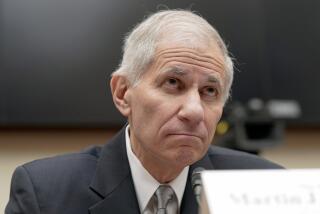Officials Hit Back at Bank Doomsayers : Banking: Two top federal regulators hold an unusual press conference to dispute gloomy predictions of impending failure for 1,000 institutions.
- Share via
WASHINGTON — Two top-ranking federal banking officials held an unusual press conference Friday to dispute widespread reports questioning the soundness of the nation’s banking system.
John LaWare, a member of the Federal Reserve Board, and Andrew C. Hove Jr., acting chairman of the Federal Deposit Insurance Corp., told reporters that a recent study claiming more than 1,000 of the nation’s 12,000 banks could fail “lacked credibility.”
The two officials acknowledged that such public criticism of private reports was unusual for Washington’s Sphinx-like collection of federal banking agencies, which ordinarily remain silent about criticism to keep financial markets calm.
But LaWare said it was necessary because claims made by critics might “undermine confidence in the banking system.” The soundness of the banking system recently emerged as an issue in the presidential campaign during the candidates’ debates.
LaWare and Hove were particularly critical of the book “Banking on the Brink--The Troubled Future of American Finance,” authored by Roger J. Vaughan, a Santa Fe, N.M., consultant, and Edward W. Hill, a Cleveland State University professor.
The book, recently published by the Washington Post Co., alleges that the bank failures could reasonably cost $45 billion to $59 billion and lead to a taxpayer bailout of the FDIC, the fund that insures banking accounts up to $100,000. The study argues that accounting gimmickry is hiding billions of dollars of bad real estate and commercial loans.
But LaWare and Hove said the book vastly exaggerates the problems of the banking system.
LaWare noted that banks have had record earnings this year with 60% of the institutions earning more than a 1% return on assets, the basic standard of solid profitability in the banking industry. He also said bank reserves for loan losses are up and noted that the vast majority of banks are meeting risk-base capital standards for 1992.
“I don’t think these facts in any way suggest an industry on the brink of disaster,” LaWare said.
The FDIC said that as of June 30, 60 banks were “significantly undercapitalized” and that 14 of those banks had been closed. The rest, officials said, are looking for merger partners or new capital. Officials said they expect about 100 bank failures next year with assets totally $77 billion.
Hove said the FDIC is currently running a $5.5-billion deficit. But he said the agency’s $16-billion reserve for losses plus a $30-billion credit line granted by Congress last year should be more than enough to handle failures in the foreseeable future. Still, concerns about the health of the nation’s banking system have increased in recent weeks with the specter of a “December surprise”--a wave of insolvencies caused by new federal banking regulations that take effect Dec. 19. The new rules raise financial requirements for banks.
The nation’s focus on the issue intensified after Ross Perot--citing published criticisms of the banking industry--raised concern about the prospects of more bank failures in Monday’s presidential debates. He raised the subject after “Banking on the Brink” was published.
Hill, one of the book’s authors, said federal officials were “mischaracterizing” the book and were “responding to pressure and concern generated by the American Bankers Assn.,” the banking industry’s leading trade group.
“This is a simple but sloppy hatchet job that tries to deflect attention from the real story: the FDIC’s unwillingness to be straight with the American people about the true conditions of the American banking industry,” he said.
But Bert Ely, a banking consultant in Alexandria, Va., and a harsh critic of government officials during the thrift crisis, said the authors’ gloomy assessment of banking is “faulty and out of sync with reality.”
More to Read
Sign up for Essential California
The most important California stories and recommendations in your inbox every morning.
You may occasionally receive promotional content from the Los Angeles Times.













